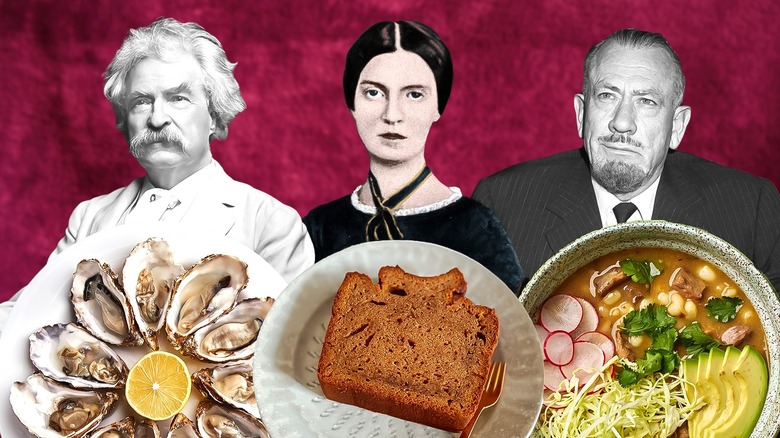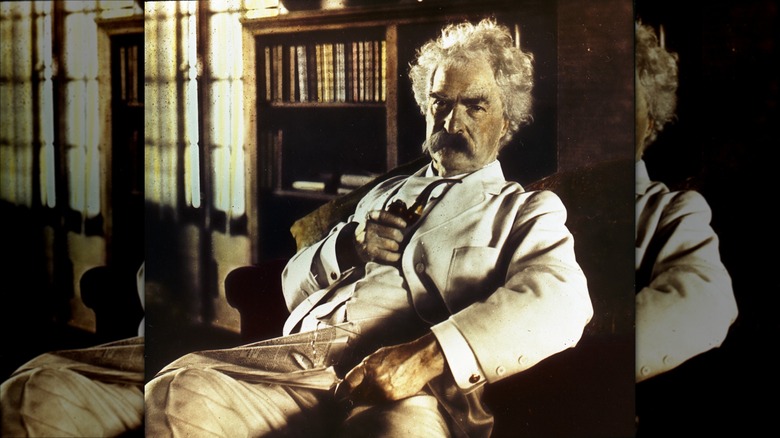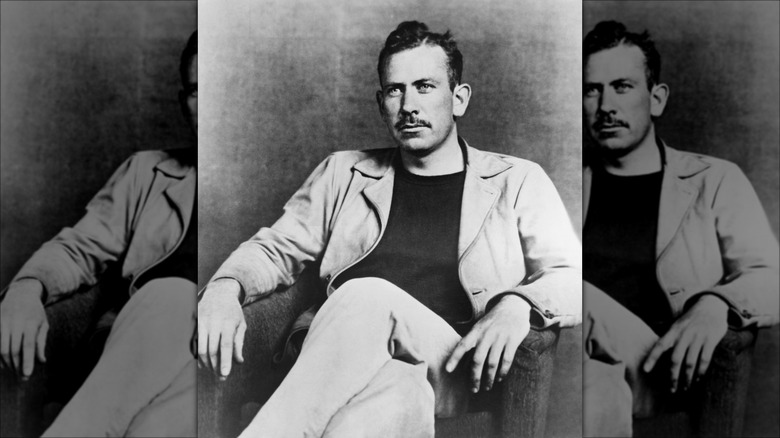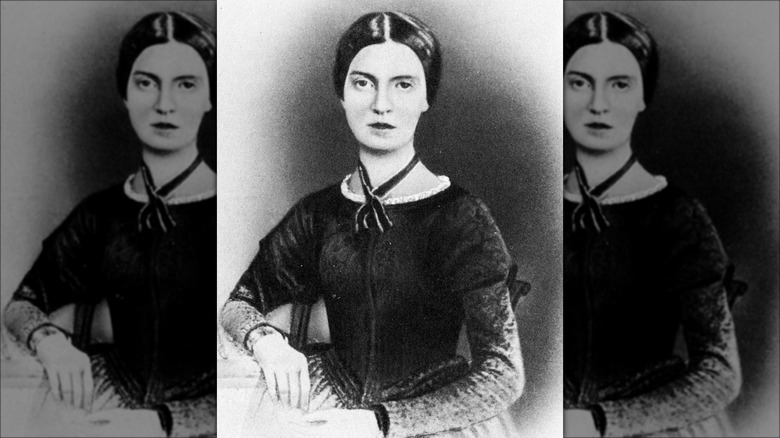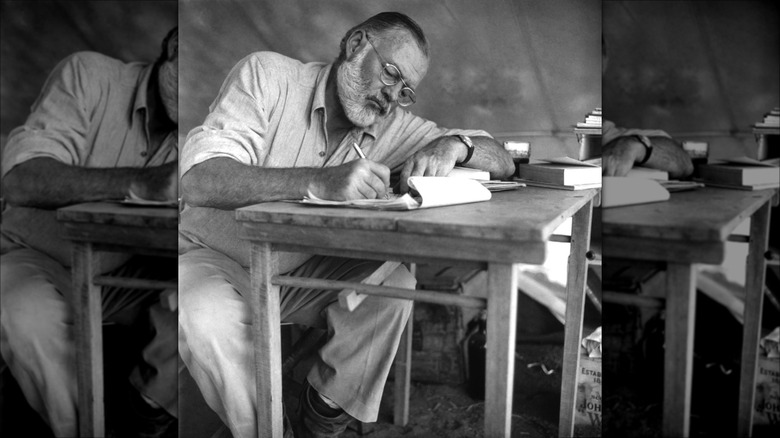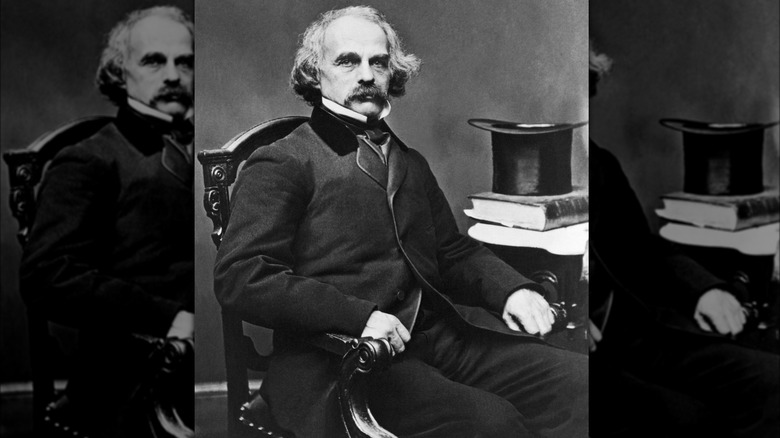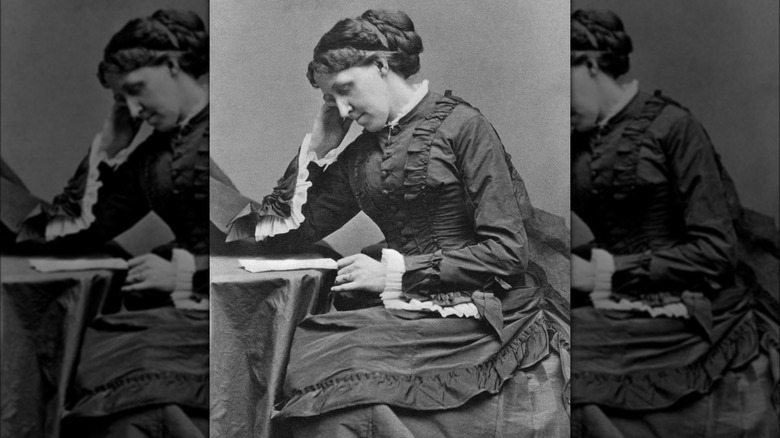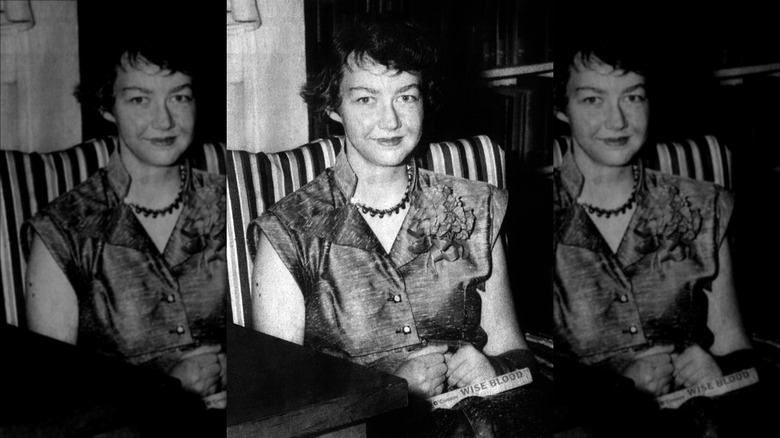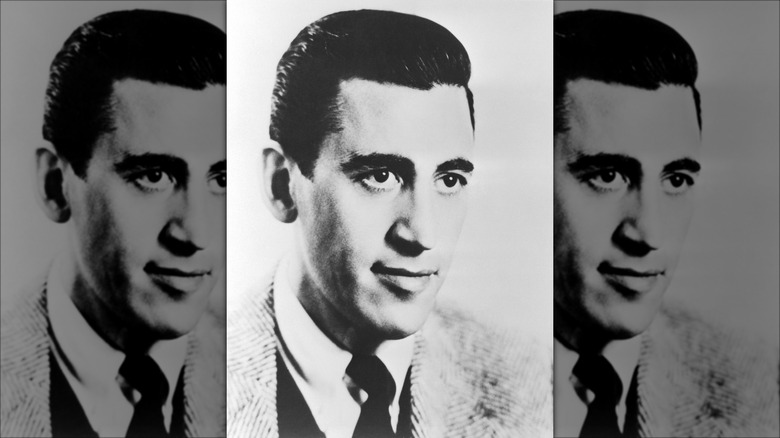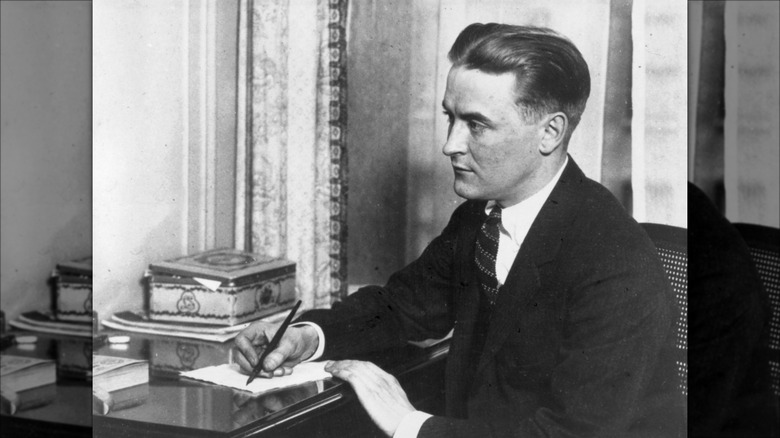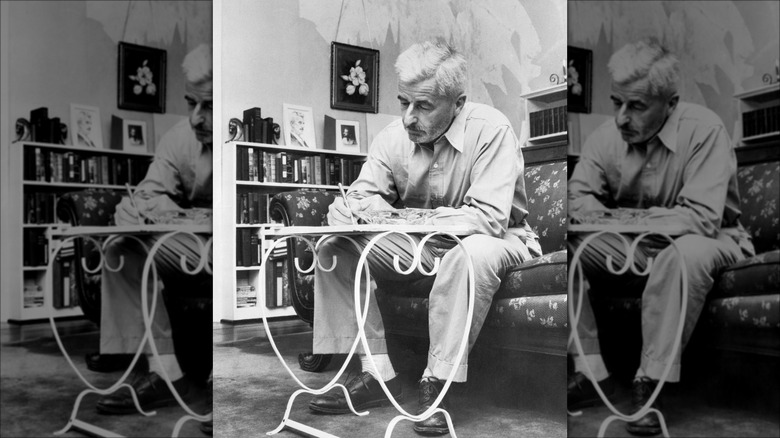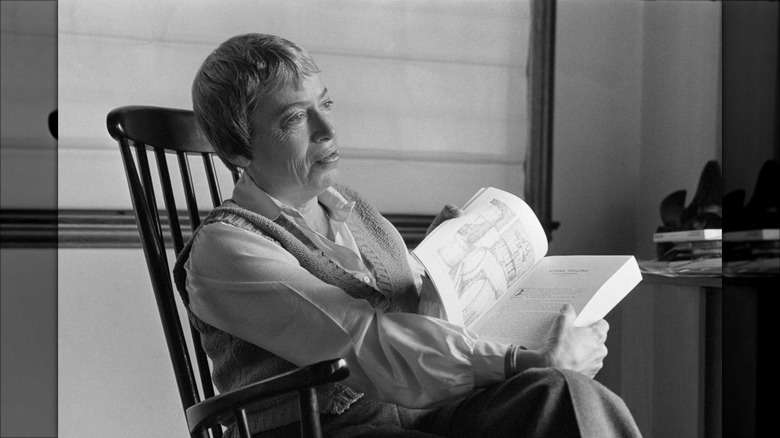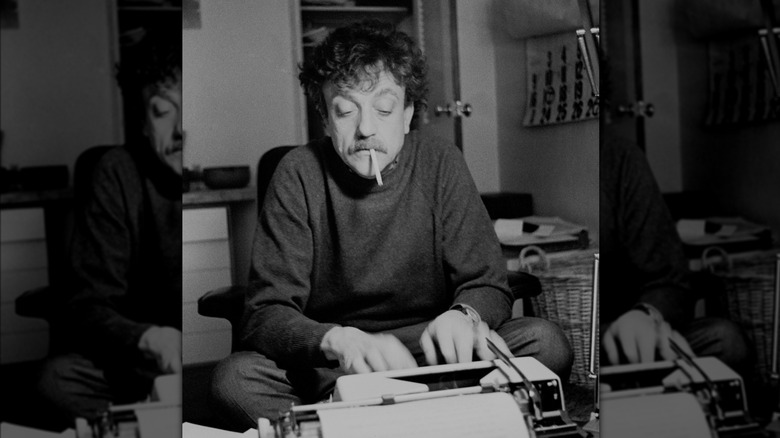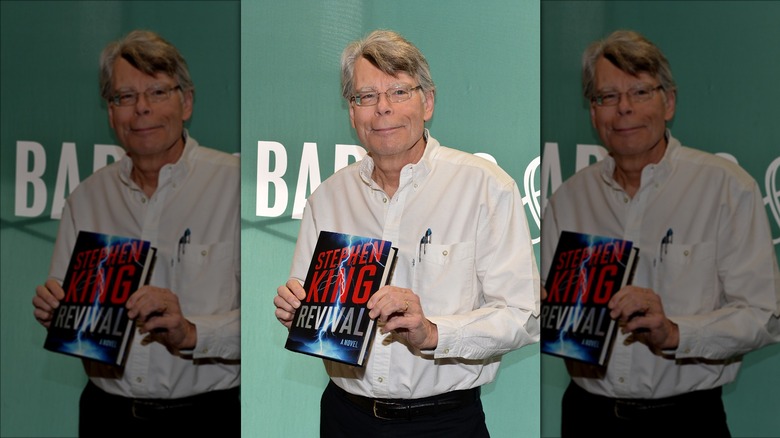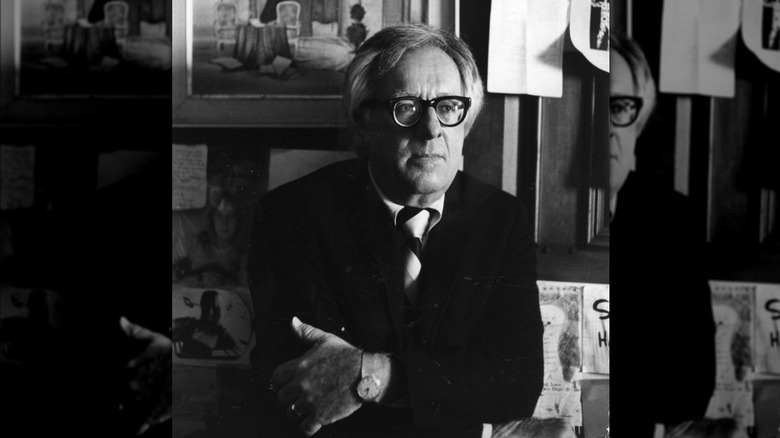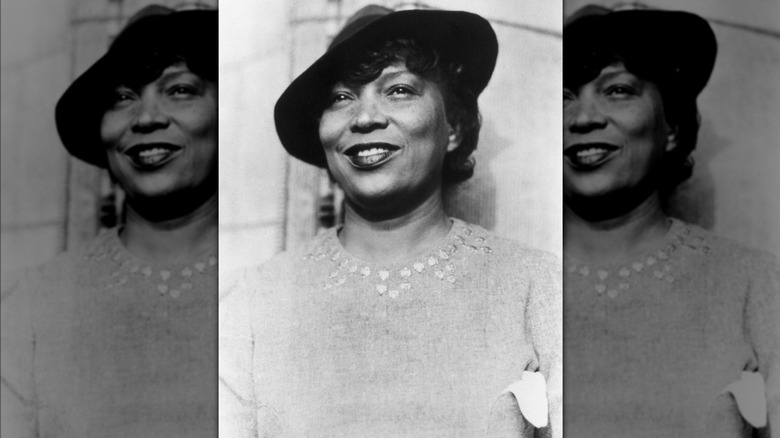15 Great American Authors And Their Favorite Foods
Is there any better pairing than a good book and your favorite snack? We don't think so — food and literature go together like peanut butter and jelly, and a book hasn't been well read until there are at least a couple of accidental culinary stains on its pages. The cozy couple can't be overstated, so it only stands to reason that some of the greatest figures in American literature are equally passionate about food.
Food seems to have played nearly as important a role in the lives of some authors as even their greatest works. Take Emily Dickinson, for example, whose bakes and poem drafts often shared kitchen counter space; or Kurt Vonnegut, whose favorite candy bar plays a central role in what is perhaps his most famous work. It probably wouldn't be far-fetched to say that authors' favorite foods may have propelled the creation of some of the greatest literature we have today. Have you ever wanted to eat like a great American author? Take a page from their books and dive into some of their most beloved dishes.
Mark Twain
If you've ever read "The Adventures of Tom Sawyer" or "The Adventures of Huckleberry Finn," you may already be intimately familiar with author Samuel Clemens, more commonly known by his pen name Mark Twain. Twain was avid for comfort food that's been long-forgotten, lost over the inevitable passage of decades. When Twain was homesick, he craved what were, at the time, classic American dishes; among them fresh butter beans, Illinois prairie hens, and Missouri partridge. Though you'd be hard-pressed to find many of these dishes nowadays, one of Mark Twain's absolute favorite foods is unlikely to ever go out of style.
When Twain visited San Francisco for long stretches of time he often stayed at the Occidental, where he indulged in oysters. He even wrote in 1864 about his desire to "destroy oysters done up in all kinds of seductive styles." Though the Olympia oysters served at the Occidental were far from being known as the best the sea has to offer (due to their slightly metallic taste), Twain became intimately fond of them. You may have to search to get your hands on the once-prolific oysters, whose population has since diminished due to over farming; but if you find some, we recommend slurping them down with a copy of one of Twain's works by your side.
John Steinbeck
Steinbeck was a foodie if there ever was one. When he wasn't drafting "The Grapes of Wrath" or "East of Eden," there's a good chance you could find him on some culinary exploit. He was passionate about cooking with and eating locally sourced foods, and it wasn't uncommon to find him fishing for his next meal. But even the most passionate culinary curators among us have a fallback meal, a food that's tasty and can be whipped up at a moment's notice when the day's toil has been simply too much. For Steinbeck, that dish was pork posole.
Steinbeck's version of this dish (the recipe for which was borrowed from screenwriter friend Jack Wagner) is admittedly plain, and consisted of "a can of chili and a can of hominy." We won't deter you from trying pork posole the Steinbeck way if you want, but if you feel the need to adapt it to modern tastebuds, consider adding onion, tomato, peppers, and herbs and spices such as oregano and paprika.
Emily Dickinson
In addition to being a poet, Emily Dickinson was also a renowned neighborhood baker. In fact, she was such a good baker that it's not unheard of for people to celebrate her birthday by baking one of her recipes — her famous black cake, the original recipe for which is now housed in Houghton Library. The Carribean-inspired cake even featured in Apple TV's "Dickinson," a series about the poet.
She was also an accomplished bread baker — in fact, her Rye and Indian bread placed in the 1856 Amherst Cattle show — and one of her most famous bakes was her gingerbread. Gingerbread was arguably Dickinson's favorite bread to bake, and for good reason — her neighbors absolutely adored it. The poet even had a tradition of lowering down baskets of gingerbread to children in her neighborhood. It wouldn't be a stretch to say that baking was a love language of hers, as it wasn't uncommon for friends to receive her delicious bakes as gifts.
Ernest Hemingway
If you've ever read any of Ernest Hemingway's works, you may have noticed that vivid descriptions of food often shine through in the author's novels. That's no accident — Hemingway was an avid explorer of the global culinary scene, and it must have been only natural for him to impart some of that love of cultural cuisines in his writing. Despite the author's intimate familiarity with foods around the world, his favorite meal was one easily found stateside.
It's widely believed that Hemingway's favorite meal was also his last. Shortly before his death by suicide, Hemingway spent an evening with his wife dining on a New York strip steak, baked potato, and Caesar salad, washing it all down with a glass of Bordeaux at Michel's Christiania Restaurant in Ketchum, Idaho. It's clear that life's simplest pleasures took priority for the author, and if you ever want to eat a meal in his honor, you might start by replicating his favorite. If you'd like to give him a toast, you could indulge instead in Hemingway's favorite rum cocktail.
Nathaniel Hawthorne
If you're at all familiar with the short, famous work "The Scarlet Letter," you may have heard of its author Nathaniel Hawthorne. The New England native had a particular fondness for sweets, and it wasn't uncommon to find him chowing down on dessert after dessert even after just having a hefty dinner. He also particularly enjoyed fruit, a love which may have stemmed from the orchards of fruit trees on his land. While he often used in-season fruits in his desserts (or as a dessert in their own right), even they couldn't take the spot of his favorite dessert. That honor went to a simple, sumptuous chocolate bread pudding.
The author is so known for loving chocolate bread pudding that the Hawthorne Hotel has the dessert on its menu under the name "Nathaniel's Bread Pudding." The hotel uses Nathaniel's original recipe and dresses it up a little with garnishes of bourbon caramel and cinnamon whipped cream. Enjoy this dessert in honor of the author by following a simple chocolate bread pudding recipe and garnishing it with fresh fruit — or, if you want to get a little fancier, turn the dessert into a layered trifle.
Louisa May Alcott
Orchards of fruit trees would also play a pivotal role in the food history of our next author, and that's no accident; after all, Louisa May Alcott was also a resident of The Wayside, the property where Nathaniel Hawthorne lived in Concord, Massachusetts. The property boasted delicious apple trees, and it's not hard to conjure up an image of Alcott drafting "Little Women" at a writing desk while enjoying pieces of the juicy fruit. Orchard apples were the central feature of her favorite dessert, apple slump, which was as easy to make as it was to chow down on.
Though the name may not sound particularly mouth-watering, the dessert most definitely is. Similar to modern-day cobblers and crumbles, an apple slump featured a layer of baked apples underneath a topping of dumpling dough. It was an easy dessert to throw together and, though it doesn't look particularly pretty, you'll hardly care once you've taken a bite. Instead of baking an apple cobbler the next time fall rolls around, take a note from Louisa's book and bake an apple slump. Eat in front of the fire alongside a glass of tea and a well-worn copy of "Little Women."
Flannery O'Connor
If there's one thing Flannery O'Connor couldn't have been afraid of, it was discomfort. The short-story author weaved together works of absurdist dark comedy with religious undertones — if you've ever read "A Good Man Is Hard To Find," you know exactly what we're talking about. If you haven't read the short story, do yourself a favor and grab a copy (or find an online PDF), and spend a few minutes reading while you indulge in O'Connor's equally absurd favorite meal: Fried shrimp and peppermint chiffon pie.
Fried shrimp and peppermint chiffon pie may seem less like an uncomfortable pairing once you consider the plain fare O'Connor grew up eating. She'd often keep her meals even as simple as a can of sardines; not because she didn't have access to finer foods, but because she simply rejected the pleasure one usually takes from them. It stands to reason that fried shrimp and peppermint chiffon pie may have been quite the indulgence for the author, though the pie was fairly plain and utilized evaporated milk, gelatin, a pre-made chocolate crust, and peppermint candies.
J.D. Salinger
After being made famous by his seminal work "The Catcher in the Rye," J.D. Salinger quickly became known as an introverted recluse who very rarely agreed to interviews and eschewed any public interest in his personal life. Though the author's inner world remains somewhat of a mystery, the public has been able to gain some knowledge of his habits and preferences; for example, he preferred Burger King to other fast food chains and was regularly spotted eating Saturday dinners solo at the First Congregational Church in Hartland, Vermont.
His favorite dish was the one served by the church every Saturday night: a monstrous amount of roast beef, mashed potatoes, and an impressive assortment of pies. He was often seen enjoying the simple, hearty meal while writing in his notebook, and we think the classic food is suitable for a famous writer with a penchant for normality and a large appetite. If there's any doubt as to how much Salinger loved this meal, it should be assuaged by the simple fact that his wife went to the church to get him a plate when the author was on his deathbed.
F. Scott Fitzgerald
Certainly no novel as deep and ambitious as "The Great Gatsby" could have been written on an empty stomach. Indeed, F. Scott Fitzgerald was a known snacker — but not on what you may think. Though his characters in "The Great Gatsby" often dined on abundant, excessively luxurious fare, Fitzgerald seemed to have been a man of simpler pleasures; or, perhaps, he only had the means to eat vicariously through his penned figures.
As it turns out, F. Scott Fitzgerald's favorite snack was about as plain as the food he wrote about was abundant. The author gained much sustenance over his lifetime by snacking on canned meat and apples, a habit which was not lost on him — in his autobiographical essay "Handle with Care" he wrote, "I...sunk all the money I had with me in a stock of potted meat, crackers, and apples." While his regularly enjoyed snack may not sound particularly appealing to the majority of us today, we can appreciate it for what it was: a clean source of brain food that propelled the creation of Fitzgerald's famous works.
William Faulkner
When one familiar with William Faulkner tries to imagine the man indulging in any type of food or drink, an image of a vat of whiskey may be brought to mind. After all, Faulkner even said himself in a 1956 interview, "My own experience has been that the tools I need for my trade are paper, tobacco, food, and a little whiskey." But alas, whiskey on its own cannot sustain a man, much less one who ends up writing over a dozen acclaimed novels. To accomplish this feat, Faulkner most certainly needed food. His preferred dish? Salmon croquettes.
Though the name may be fancy, there was nothing special about the way Faulkner took his croquettes. He didn't have his own secret recipe or fancy ingredients — rather, he made the recipe straight off the side of the canned pink salmon he used for the croquettes. To enjoy this dish Faulkner-style, it's almost imperative that you give canned salmon croquettes a try. If you want to make something a bit more sophisticated for a literary-themed dinner party feel free to turn salmon fillets into croquettes to honor the author.
Ursula K. Le Guin
Any fan of literary science fiction is bound to have at least heard of Ursula K. Le Guin, if not read one (or many) of the 22 books she published before her death in 2018. The author's sci-fi books are highly acclaimed both for their gorgeous prose and daring narrative styles. It's easy to expect an author of this ilk to have some more peculiar foodie habits, but in contrast to her novels, Le Guin's favorite fare was refreshingly simple and down-to-earth: She regularly enjoyed a breakfast of berries, tea, an English muffin, and a soft-boiled egg.
The food may be simple, but the story behind it is not. Le Guin's penchant for soft-boiled eggs was partially born of guilt after she asked the egg to be left off of her breakfast when ordering from a cafe one day. The waiter's befuddlement led her to conclude that she had "willfully and needlessly disturbed the order of that waiter's universe ... a stable, orderly, perfected one," according to Le Guin's blog. Her self-imposed tradition of then indulging in a soft-boiled egg for breakfast every morning became ceremonial, and every aspect from the preparation to the serving and eating of the breakfast was meticulously ordered.
Kurt Vonnegut
When you think of Kurt Vonnegut and his often satirical novels, it's easy to imagine a tragic life peppered with the same comedic disdain that comes through in the pages of some of his most famous works. Vonnegut's life was by no means easy — he served in World War II and was even a prisoner of war at Dresden for a time, the experience of which inspired his novel "Slaughterhouse-Five" — but one thing he did take particular enjoyment in was food. His favorite food was one he dreamed of eating while serving in the war — candy bars.
Carl Shields, Vonnegut's biographer, recounts Vonnegut's obsession with imagining the taste of candy bars during wartime in "And So It Goes." Vonnegut couldn't stay away from the treat in his writing, either — the Three Musketeers phrase is used often in "Slaughterhouse-Five." But Vonnegut's fondness for childlike food doesn't end there. The writer often preferred hot chocolate to coffee even when having guests over, and would regularly ask his daughter for a grilled cheese.
Stephen King
Anyone well-versed in Stephen King's works may find it hard to believe that the author himself eats anything besides the blandest of foods. His characters sometimes seem to enjoy nothing but, often dining on meals consisting of beans or pizza. To be fair, King himself doesn't regularly dine on gourmet meals — though he's accomplished some impressive culinary feats, even becoming an accomplished bread baker, he's known to enjoy a microwaved meal not infrequently. However, his favorite food is far from being simple to prepare.
King's favorite indulgence is dessert — more specifically, cheesecake. The author is known to enjoy a slice of cheesecake (his preferred brain food) before sitting down to write. Contrasting with his simpler meals, King's cheesecakes take as much care to prepare as his finely crafted novels, and he doesn't cut corners when baking his favorite dessert. The next time you set out to bake the perfect cheesecake, do it authentically — water bath and all — in honor of King.
Ray Bradbury
A visionary author if there ever was one, Ray Bradbury spent much of his life and career projecting far into the future, outside the reaches of Earth and beyond the modern limitations of science yet undiscovered. His gift for foreseeing the unknown, however, didn't extend to his culinary habits, which tended toward the conservative. The writer, who was always on a budget, found himself not infrequently dining on common foods like egg sandwiches and burgers — partially because they were affordable and partially because they suited his once-picky palate.
Though he eventually expanded his culinary horizons, one of his simple pleasures would endure throughout his life: Tomato soup. And Bradbury wasn't partial to fancy soups, either. The simpler the better (possibly because it left more time for writing), and Bradbury regularly made canned tomato soup for dinner. He wanted his love for the food to be memorialized even after his death, at one time saying, "I want to arrive in a Campbell's soup can. Bury me on Mars in the thing called the Bradbury Abyss."
Zora Neale Hurston
To merely call Zora Neale Hurston an author would be to tarnish her rich and prolific legacy. In addition to authoring novels and short stories, Hurston also wrote plays, was a cultural anthropologist focusing on Black folklore, established a dramatic arts school, and even worked as a drama teacher. As all-encompassing as her work was, especially in Black cultural anthropology, it's not hard to imagine that food traditions also played a heavy role in Hurston's life. There's even a whole book dedicated to exploring Hurston's relationship with the food of her Florida homeland.
Her favorite Floridian dish (to cook, anyway) was arguably fried shrimp and okra, served alongside homemade buttermilk cornbread. Hurston is so known for the food that it's not uncommon to see restaurants serving up their version of the dish in her honor. Hurston's dish was almost certainly simple yet delicious, as she frequently operated on a sparse budget. If you plan on making this dish in remembrance of Hurston, be sure to offer some to your community alongside a copy of "Their Eyes Were Watching God."
